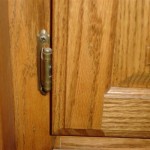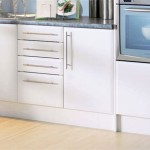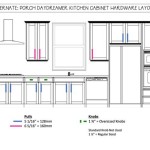Painted or Stained Kitchen Cabinets: A Comprehensive Guide
The selection of kitchen cabinets is a pivotal decision in any kitchen renovation or construction project. Beyond functionality, cabinets significantly contribute to the overall aesthetic and impact the perceived value of the space. One of the primary choices homeowners face is whether to opt for painted or stained kitchen cabinets. Both options offer unique advantages and disadvantages, influencing not only the style but also the durability, maintenance, and long-term appearance of the kitchen.
Understanding the characteristics of painted and stained cabinets is crucial for making an informed decision that aligns with individual preferences, lifestyle, and budget. This article will delve into the intricacies of each option, providing a comprehensive analysis of their respective features and considerations.
Aesthetic Considerations: Paint vs. Stain
The visual impact of painted and stained cabinets differs significantly. Painted cabinets offer a broader spectrum of color choices. Almost any color imaginable can be achieved with paint, allowing for customization and coordination with other kitchen elements. This versatility makes paint a popular choice for homeowners seeking a modern, contemporary, or eclectic design scheme. Paint also provides a uniform finish, concealing the natural grain of the wood and creating a clean, sleek look. This smooth surface can be particularly effective in smaller kitchens, as it can help to create a sense of spaciousness and light.
Stained cabinets, on the other hand, enhance the natural beauty of the wood grain. The stain penetrates the wood surface, highlighting its texture and patterns. This option is typically favored for traditional, rustic, or farmhouse-style kitchens. Stains come in a variety of shades, ranging from light and airy to dark and rich, allowing homeowners to choose a color that complements the wood species and the overall design aesthetic. The inherent variations in the wood grain create a sense of warmth and character, adding depth and visual interest to the kitchen.
The choice between paint and stain often depends on the desired mood and ambiance of the kitchen. Paint can create a bright and cheerful atmosphere, while stain can evoke a sense of warmth and sophistication. Ultimately, the decision rests on individual preferences and the overarching design vision.
Durability and Maintenance: Performance Over Time
The durability and maintenance requirements of painted and stained cabinets are also important factors to consider. Painted cabinets are generally more susceptible to chipping, scratching, and wear, especially in high-traffic areas such as around handles and countertops. The paint finish can also fade or yellow over time, particularly in direct sunlight. To mitigate these issues, it is essential to choose high-quality paint and apply a durable topcoat. Regular cleaning and touch-ups are also necessary to maintain the appearance of painted cabinets.
Stained cabinets tend to be more resistant to scratches and wear. Because the stain penetrates the wood, minor imperfections are less noticeable. Additionally, stained cabinets are less prone to fading or yellowing compared to painted cabinets. However, stained cabinets can still be susceptible to water damage and require regular cleaning to prevent the buildup of grime and grease. A protective topcoat can help to enhance the durability and water resistance of stained cabinets.
The choice between paint and stain should also take into account the lifestyle of the homeowner. Families with young children or pets may find that stained cabinets are a more practical option, as they are more forgiving of everyday wear and tear. Homeowners who are meticulous about cleaning and maintenance may prefer painted cabinets, as they offer a wider range of color choices and a more modern aesthetic.
Cost Considerations: Initial Investment and Long-Term Expenses
The cost of painted and stained cabinets can vary depending on several factors, including the type of wood, the complexity of the design, and the quality of the materials and workmanship. Generally, painted cabinets tend to be more expensive than stained cabinets. This is because the painting process typically requires more labor and materials, including priming, multiple coats of paint, and a protective topcoat. The cost of high-quality paint can also be significant.
Stained cabinets are generally less expensive because the staining process is simpler and requires fewer materials. The cost of stain is typically lower than the cost of paint. However, the cost of stained cabinets can increase if the homeowner chooses a rare or exotic wood species. The complexity of the staining process can also impact the overall cost.
In addition to the initial investment, it is important to consider the long-term expenses associated with each option. Painted cabinets may require more frequent touch-ups and repairs, which can add to the overall cost. Stained cabinets may require less maintenance, but they may need to be refinished or re-stained after several years. The cost of refinishing or re-staining can be significant, especially if the homeowner chooses to hire a professional.
When budgeting for kitchen cabinets, it is essential to obtain quotes from multiple contractors and suppliers. This will allow homeowners to compare prices and make an informed decision that aligns with their budget and needs.
Wood Species and Grain: Impact on Finish
The type of wood used for kitchen cabinets plays a significant role in how both paint and stain will appear. Certain wood species are better suited for painting, while others are ideal for staining. For painted cabinets, hardwoods like maple, poplar, and birch are often preferred. These woods have a tight grain pattern, which allows for a smooth and uniform finish. They also tend to be less prone to knots and imperfections, which can show through the paint.
For stained cabinets, woods with prominent grain patterns, such as oak, cherry, and hickory, are commonly used. The stain enhances the natural beauty of the wood grain, creating a rich and textured look. The choice of wood species will also influence the color of the stain. For example, oak tends to absorb stain more readily than maple, resulting in a darker and more pronounced color. Cherry wood, known for its reddish-brown hue, will impart a warm tone to any stain applied.
It is important to consider the grain pattern and wood species when choosing between paint and stain. Homeowners who prefer a clean and uniform look may opt for painted maple cabinets. Those who appreciate the natural beauty of wood may prefer stained oak or cherry cabinets.
Environmental Considerations: VOCs and Sustainability
The environmental impact of painted and stained cabinets is another factor to consider. Many paints and stains contain volatile organic compounds (VOCs), which are harmful chemicals that can contribute to air pollution. It is important to choose low-VOC or zero-VOC paints and stains to minimize the environmental impact and protect indoor air quality.
The sourcing of the wood is also an important consideration. Choosing sustainably harvested wood can help to protect forests and promote responsible forestry practices. Look for cabinets that are certified by the Forest Stewardship Council (FSC) or other reputable organizations. These certifications ensure that the wood has been harvested in an environmentally responsible manner.
The manufacturing process of the cabinets can also have an environmental impact. Some manufacturers use eco-friendly manufacturing practices, such as using recycled materials and reducing waste. Choosing cabinets from a manufacturer that is committed to sustainability can help to reduce the overall environmental footprint of the kitchen renovation project.
By considering the environmental impact of painted and stained cabinets, homeowners can make a more informed and responsible decision.
Style and Design Trends: Adapting to Modern Aesthetics
Current kitchen design trends often influence the choice between painted and stained cabinets. While stained cabinets have long been associated with traditional styles, they are also finding a place in modern and transitional designs. Light-colored stains, such as natural or whitewashed finishes, are becoming increasingly popular for creating a bright and airy kitchen.
Painted cabinets remain a staple in contemporary kitchens, particularly in shades of white, gray, and navy blue. These colors provide a neutral backdrop for other design elements, such as countertops, backsplashes, and hardware. Bold and vibrant colors are also being used to create accent walls and add personality to the kitchen.
The choice between paint and stain can also be influenced by the architectural style of the home. In older homes with traditional architecture, stained cabinets may be a more fitting choice. In newer homes with modern architecture, painted cabinets may be a better option. Ultimately, the decision should be based on personal preferences and the overall design aesthetic of the home.
Mixing painted and stained cabinets is also a popular trend, allowing homeowners to create a unique and personalized kitchen design. For example, the upper cabinets can be painted white to create a sense of spaciousness, while the lower cabinets can be stained wood to add warmth and character.
Professional Installation vs. DIY: Considerations for Success
The installation of kitchen cabinets can be a complex and challenging task, especially for inexperienced homeowners. While some homeowners may choose to install the cabinets themselves, professional installation is generally recommended. Professional installers have the expertise and equipment to ensure that the cabinets are installed correctly and securely. They can also handle any unexpected challenges that may arise during the installation process.
DIY installation can save money, but it also carries risks. Incorrect installation can lead to problems such as uneven cabinets, loose hinges, and damaged walls. These problems can be costly to fix and can also detract from the overall appearance of the kitchen.
Before deciding to install the cabinets themselves, homeowners should carefully assess their skills and experience. They should also consider the complexity of the installation and the potential risks involved. If they are unsure of their abilities, they should hire a professional installer.
Whether the cabinets are painted or stained, proper installation is essential for ensuring their long-term performance and appearance.
In summary, the decision between painted and stained kitchen cabinets involves a careful evaluation of aesthetic preferences, durability considerations, cost factors, wood species, environmental concerns, design trends, and installation options. A thorough understanding of these aspects will empower homeowners to make an informed choice that reflects their individual needs and creates a kitchen that is both beautiful and functional.

Painted Vs Stained Cabinets Which Fits Your Style Best

Painted Vs Stained Cabinets Which One To Choose Sir Paints A Lot

Painted Cabinets Staining Kitchen

Painted Vs Stained Cabinets Jm Kitchen And Bath Design

Out Of Curiosity Painted Or Stained Kitchen Cabinets Addicted 2 Decorating

Stained Vs Painted Kitchen Cabinets

Kitchen Cabinet Color Should You Paint Or Stain

Painted Vs Stained Cabinets How To Compare When Use Both

Custom Kitchen Cabinets Painted Vs Stained Apico Kitchens

Painted Cabinets Staining Kitchen
Related Posts








